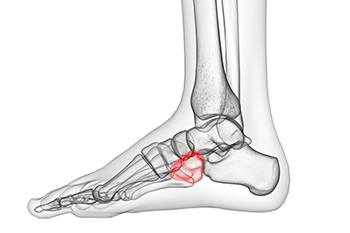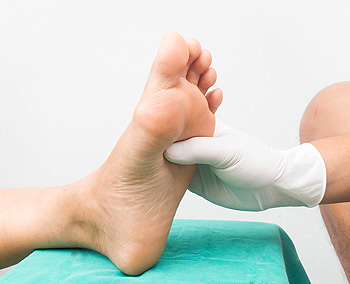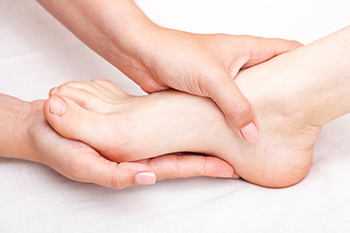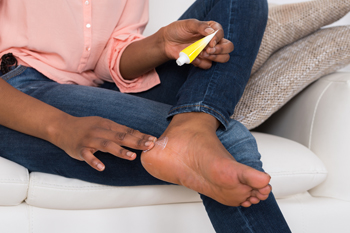Connect With Us
Blog
Items filtered by date: September 2021
Do I Have Cuboid Syndrome?
 The cuboid bone is one of 8 tarsal bones in the foot that sits just on the outside of the foot near the ankle. When this bone becomes dislocated (either partially or completely), cuboid syndrome may occur. Cuboid syndrome often occurs after an ankle sprain, but it can happen without any other injury. If the peroneal muscle that attaches to the bone pulls the bone too hard, the cuboid can dislocate. Two common symptoms of cuboid syndrome include pain on the outside of the foot (especially when bearing weight) and overpronation of the feet (where they either roll in or flatten). Patients who believe that they may have cuboid syndrome should consult with a podiatrist. A podiatrist will be able to put the bone back into proper alignment, as well as provide suggestions for helping to keep the bone in place.
The cuboid bone is one of 8 tarsal bones in the foot that sits just on the outside of the foot near the ankle. When this bone becomes dislocated (either partially or completely), cuboid syndrome may occur. Cuboid syndrome often occurs after an ankle sprain, but it can happen without any other injury. If the peroneal muscle that attaches to the bone pulls the bone too hard, the cuboid can dislocate. Two common symptoms of cuboid syndrome include pain on the outside of the foot (especially when bearing weight) and overpronation of the feet (where they either roll in or flatten). Patients who believe that they may have cuboid syndrome should consult with a podiatrist. A podiatrist will be able to put the bone back into proper alignment, as well as provide suggestions for helping to keep the bone in place.
Cuboid syndrome, also known as cuboid subluxation, occurs when the joints and ligaments near the cuboid bone in the foot become torn. If you have cuboid syndrome, consult with Philip K. Schrumpf, DPM from Active Feet Clinic. Our doctor will assess your condition and provide you with quality foot and ankle treatment.
Cuboid syndrome is a common cause of lateral foot pain, which is pain on the outside of the foot. The condition may happen suddenly due to an ankle sprain, or it may develop slowly overtime from repetitive tension through the bone and surrounding structures.
Causes
The most common causes of cuboid syndrome include:
- Injury – The most common cause of this ailment is an ankle sprain.
- Repetitive Strain – Tension placed through the peroneus longus muscle from repetitive activities such as jumping and running may cause excessive traction on the bone causing it to sublux.
- Altered Foot Biomechanics – Most people suffering from cuboid subluxation have flat feet.
Symptoms
A common symptom of cuboid syndrome is pain along the outside of the foot which can be felt in the ankle and toes. This pain may create walking difficulties and may cause those with the condition to walk with a limp.
Diagnosis
Diagnosis of cuboid syndrome is often difficult, and it is often misdiagnosed. X-rays, MRIs and CT scans often fail to properly show the cuboid subluxation. Although there isn’t a specific test used to diagnose cuboid syndrome, your podiatrist will usually check if pain is felt while pressing firmly on the cuboid bone of your foot.
Treatment
Just as the range of causes varies widely, so do treatments. Some more common treatments are ice therapy, rest, exercise, taping, and orthotics.
If you have any questions, please feel free to contact our office located in Missoula, MT . We offer the newest diagnostic and treatment technologies for all your foot care needs.
Proper Foot Care for Diabetic Feet
 Diabetic patients are often aware of the link between foot problems and how their diabetes is managed. Complications can include a numbing sensation or tingling in the feet which may be the beginning of diabetic neuropathy. It may cause the inability to feel existing cuts, wounds, or bruises. If these ailments are left untreated, a diabetic ulcer may form, which may lead to amputation. Additionally, foot muscles may be affected in severely diabetic patients, which may change the alignment of the foot. Proper foot care management can begin with monitoring the glucose levels in the blood. A daily practice of good foot hygiene can consist of washing and drying the feet thoroughly, and special footwear may need to be worn. If you have diabetes, it is strongly suggested that you are under the care of a podiatrist who can help you to properly manage this condition, in addition to providing you with proper foot care advice.
Diabetic patients are often aware of the link between foot problems and how their diabetes is managed. Complications can include a numbing sensation or tingling in the feet which may be the beginning of diabetic neuropathy. It may cause the inability to feel existing cuts, wounds, or bruises. If these ailments are left untreated, a diabetic ulcer may form, which may lead to amputation. Additionally, foot muscles may be affected in severely diabetic patients, which may change the alignment of the foot. Proper foot care management can begin with monitoring the glucose levels in the blood. A daily practice of good foot hygiene can consist of washing and drying the feet thoroughly, and special footwear may need to be worn. If you have diabetes, it is strongly suggested that you are under the care of a podiatrist who can help you to properly manage this condition, in addition to providing you with proper foot care advice.
Diabetic foot care is important in preventing foot ailments such as ulcers. If you are suffering from diabetes or have any other concerns about your feet, contact Philip K. Schrumpf, DPM from Active Feet Clinic. Our doctor can provide the care you need to keep you pain-free and on your feet.
Diabetic Foot Care
Diabetes affects millions of people every year. The condition can damage blood vessels in many parts of the body, especially the feet. Because of this, taking care of your feet is essential if you have diabetes, and having a podiatrist help monitor your foot health is highly recommended.
The Importance of Caring for Your Feet
- Routinely inspect your feet for bruises or sores.
- Wear socks that fit your feet comfortably.
- Wear comfortable shoes that provide adequate support.
Patients with diabetes should have their doctor monitor their blood levels, as blood sugar levels play such a huge role in diabetic care. Monitoring these levels on a regular basis is highly advised.
It is always best to inform your healthcare professional of any concerns you may have regarding your feet, especially for diabetic patients. Early treatment and routine foot examinations are keys to maintaining proper health, especially because severe complications can arise if proper treatment is not applied.
If you have any questions please feel free to contact our office located in Missoula, MT . We offer the newest diagnostic and treatment technologies for all your foot and ankle needs.
A Common Symptom of Tarsal Tunnel Syndrome
 The tarsal tunnel is an area of the foot that is found below that ankle, and if it becomes inflamed as a result of an injury, tarsal tunnel syndrome may develop. This is caused by nerve that is located inside of the tarsal tunnel, called the tibial nerve, becoming pressed. A common symptom that is associated with this condition can consist of a burning sensation under the foot, and it could radiate to the toes and the heels. Walking may intensify this ailment, as it causes pressure to be put on the tibial nerve. If you have this type of pain, and it is hindering accomplishing daily activities, there are many options that are available for treatment. Please consult with a podiatrist who can recommend the best type of treatment for you.
The tarsal tunnel is an area of the foot that is found below that ankle, and if it becomes inflamed as a result of an injury, tarsal tunnel syndrome may develop. This is caused by nerve that is located inside of the tarsal tunnel, called the tibial nerve, becoming pressed. A common symptom that is associated with this condition can consist of a burning sensation under the foot, and it could radiate to the toes and the heels. Walking may intensify this ailment, as it causes pressure to be put on the tibial nerve. If you have this type of pain, and it is hindering accomplishing daily activities, there are many options that are available for treatment. Please consult with a podiatrist who can recommend the best type of treatment for you.
Tarsal tunnel syndrome can be very uncomfortable to live with. If you are experiencing tarsal tunnel syndrome, contact Philip K. Schrumpf, DPM of Active Feet Clinic. Our doctor can provide the care you need to keep you pain-free and on your feet.
Tarsal Tunnel Syndrome
Tarsal tunnel syndrome, which can also be called tibial nerve dysfunction, is an uncommon condition of misfiring peripheral nerves in the foot. The tibial nerve is the peripheral nerve in the leg responsible for sensation and movement of the foot and calf muscles. In tarsal tunnel syndrome, the tibial nerve is damaged, causing problems with movement and feeling in the foot of the affected leg.
Common Cause of Tarsal Tunnel Syndrome
- Involves pressure or an injury, direct pressure on the tibial nerve for an extended period of time, sometimes caused by other body structures close by or near the knee.
- Diseases that damage nerves, including diabetes, may cause tarsal tunnel syndrome.
- At times, tarsal tunnel syndrome can appear without an obvious cause in some cases.
The Effects of Tarsal Tunnel Syndrome
- Different sensations, an afflicted person may experience pain, tingling, burning or other unusual sensations in the foot of the affected leg.
- The foot muscles, toes and ankle become weaker, and curling your toes or flexing your foot can become difficult.
- If condition worsens, infections and ulcers may develop on the foot that is experiencing the syndrome.
A physical exam of the leg can help identify the presence of tarsal tunnel syndrome. Medical tests, such as a nerve biopsy, are also used to diagnose the condition. Patients may receive physical therapy and prescriptive medication. In extreme cases, some may require surgery.
If you have any questions please feel free to contact our office located in Missoula, MT . We offer the newest diagnostic and treatment technologies for all your foot and ankle needs.
Wounds That Don't Heal Need to Be Checked
Foot Care for Dry, Cracked Heels
Dry, cracked heels can be annoying to deal with on a daily basis. They can even be painful when left untreated. Cracked heels are often caused by a lack of moisture and this can result from cold winter weather, dehydration, exposing your feet to hot water for prolonged periods of time, or scrubbing your feet while they are dry. Certain skin conditions, such as eczema and psoriasis, can also make the heels very dry. Having a good foot care regiment at home can help alleviate dry, cracked heels. Your foot care routine may include soaking the feet in warm water, exfoliating the heels with a pumice stone, thoroughly drying your feet with a towel, and then applying a heavy moisturizing cream. If the cracks on your heels become so deep that they bleed, these are known as fissures and can lead to an infection. When your cracked heels are painful, bleeding, or if you have diabetes, it is strongly suggested that you see a podiatrist for treatment.
If the skin on your feet starts to crack, you may want to see a podiatrist to find treatment. If you have any concerns, contact Philip K. Schrumpf, DPM from Active Feet Clinic. Our doctor can provide the care you need to keep you pain-free and on your feet.
Cracked Heels
It is important to moisturize your cracked heels in order to prevent pain, bleeding, and infection. The reason cracked heels form is because the skin on the foot is too dry to support the immense pressure placed on them. When the foot expands, the dry skin on the foot begins to split.
Ways to Help Heal Them
- Invest in a good foot cream
- Try Using Petroleum Jelly
- Ease up on Soaps
- Drink Plenty of Water
Ways to Prevent Cracked Heels
- Moisturize After Showering
- Skip a Shower
- Keep Shower Water Lukewarm
- Don’t Scrub Your Feet
If you are unsure how to proceed in treating cracked heels, seek guidance from a podiatrist. Your doctor will help you with any questions or information you may need.
If you have any questions, please feel free to contact our office located in Missoula, MT . We offer the newest diagnostic and treatment technologies for all your foot care needs.
Blog Archives
- August 2024
- July 2024
- June 2024
- May 2024
- April 2024
- March 2024
- February 2024
- January 2024
- December 2023
- November 2023
- October 2023
- September 2023
- August 2023
- July 2023
- June 2023
- May 2023
- April 2023
- March 2023
- February 2023
- January 2023
- December 2022
- November 2022
- October 2022
- September 2022
- August 2022
- July 2022
- June 2022
- May 2022
- April 2022
- March 2022
- February 2022
- January 2022
- December 2021
- November 2021
- October 2021
- September 2021
- August 2021
- July 2021
- June 2021
- May 2021
- April 2021
- March 2021
- February 2021
- January 2021
- December 2020
- November 2020
- October 2020
- September 2020
- August 2020
- July 2020
- June 2020
- May 2020
- April 2020
- March 2020
- February 2020
- January 2020
- December 2019
- November 2019
- October 2019
- September 2019
- August 2019
- July 2019
- June 2019
- May 2019
- April 2019
- March 2019


